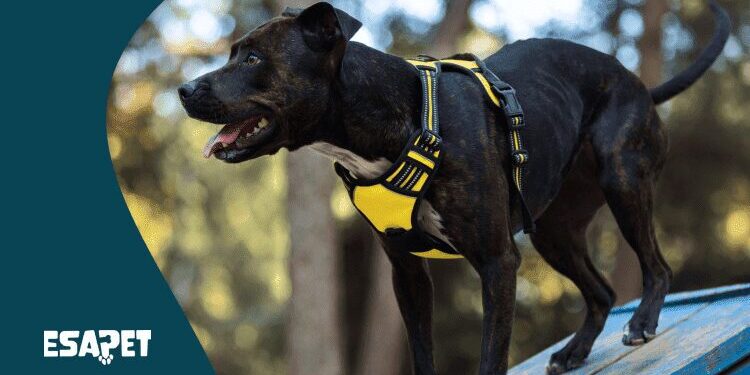Complete List of Psychiatric Service Dog Tasks (2026 Guide)

Psychiatric service dogs (PSDs) are crucial for people with mental health conditions. Through specialized dog training, they perform tasks that help manage daily challenges. These PSD tasks boost independence and improve well-being, making life easier and safer for their handlers.
Psychiatric Service Dogs Tasks Overview
PSDs help people with psychiatric disabilities like PTSD, anxiety, depression, and ADHD. They are considered service animals under the law. These dogs are trained to assist with mental health challenges. Their tasks make life easier for their disabled handler every day.
These dogs are trained to interrupt anxiety attacks, provide comfort, and remind their handler to take medication. They offer deep pressure therapy during panic attacks. Under the Americans with Disabilities Act, a dog trained to help in this way has special rights.
Everyday Tasks Performed by Psychiatric Service Dogs
PSDs offer crucial help to those with mental health conditions. Their tasks are tailored to fit the handler’s specific needs. These dogs assist with daily challenges, making life more manageable and less stressful.
Unlike emotional support animals, they go beyond being companions. Their training prepares them to perform tasks that reduce anxiety and provide comfort. Their work is practical and supportive and, with a PSD Letter, they have several housing, travel and public access rights. Let’s explore some of the key tasks they perform every day.
PSDs carry out the essential tasks to support their handler’s well-being. Each task addresses specific mental health needs and improves daily life.
Medication Reminders
Service dogs prompt their handler to take medication on time. This helps individuals stay on track with their treatment. The dog may nudge or alert the handler when it’s time for medication. This task is essential for maintaining consistency and avoiding missed doses.
Waking from Nightmares
For handlers with PTSD, PSDs are trained to wake them from nightmares. The dog may gently touch or nudge the handler to disrupt distressing dreams. This helps reduce the lingering effects of the nightmare and ensures the handler feels safe again.
Grounding Techniques
Grounding is another task PSDs perform. They offer physical contact during distress, helping the handler stay calm and present. This task is useful during panic or anxiety attacks, as it can bring the handler back to reality and ease emotional turmoil.
Crowd Control
Service dogs create personal space for their handler in crowded environments. They position themselves in a way that blocks or reduces contact with others. This helps ease feelings of anxiety in overwhelming spaces.
Routine Assistance
Service dogs can help their handler maintain a consistent daily routine. They may remind their handler of specific tasks or appointments. This task helps individuals stay organized, especially when mental health challenges make sticking to a routine difficult.
Tactile Stimulation
Tactile stimulation involves the service dog applying gentle, repetitive physical contact—such as nudging, pawing, or leaning—to interrupt harmful or anxious behaviors. This soothing touch can lower heart rate, reduce tension, and promote a sense of safety during stressful situations.
Psychiatric Service Dog Tasks for ADHD
PSDs provide crucial support for individuals with ADHD, helping with focus, structure, and managing impulses. The psychiatric service dog tasks for ADHD are tailored to assist with the daily challenges.
Now, let’s examine PSD tasks for ADHD. These dogs provide consistent assistance. This helps their handler navigate the symptoms of ADHD more effectively.
- Routine Reminders
Service dogs help individuals with ADHD follow a daily routine. They provide reminders for important tasks, such as appointments or deadlines. This task ensures the handler remains on schedule, reducing the chance of missing essential activities. - Reducing Impulsivity
These dogs help control impulsive behaviors. They may intervene by nudging or distracting the handler during impulsive moments. This helps the handler avoid rash decisions and promotes better self-control. - Providing Tactile Stimulation
Task tactile stimulation is another important task. The dog offers physical contact, such as pawing or leaning against the handler. This action helps the handler calm down in overstimulating environments. It allows the handler to regain control and reduce hyperactivity.
Emergency Tasks Performed by Psychiatric Service Dogs
PSDs are also trained to handle emergency situations. They respond quickly when their handler faces critical moments. These dogs help their handlers stay safe and calm during distressing episodes. Their quick actions can make a significant difference in these challenging times.
Each emergency task is designed to provide immediate relief or assistance. These dogs are trained to act based on their handler’s specific needs. Whether it’s calming panic attacks or finding safe spaces, their role is vital in emergencies.
Each task is crucial in ensuring the safety and well-being of their handler during critical situations. Here are some of the common tasks:
Interrupting Panic Attacks
PSDs are trained to interrupt panic attacks. They use grounding techniques like pawing or nudging to bring their handler back to reality. This task helps prevent the attack from escalating and keeps the handler calm and focused.
Alerting to Harmful Behaviors
Service dogs can alert their handlers to harmful behaviors. If the handler shows signs of self-harm or harmful actions, the dog intervenes. The dog may nudge or distract the handler, helping to prevent injury. This task is essential in moments of emotional distress.
Finding Safe Locations
In emergencies, PSDs can help locate a safe place. They guide their handler to a calm, secure environment away from danger or stress. This task is crucial during overwhelming situations, allowing the handler to feel safe and protected.
Psychiatric Service Dog Tasks for Anxiety
PSDs help handlers manage anxiety through specific tasks. These tasks are tailored to prevent or reduce anxiety symptoms. Their assistance helps the handler regain control and calm during stressful moments.
With this support, individuals can handle anxiety more effectively. These tasks offer immediate relief and ongoing support. It ensures the handler feels grounded and reassured. Let’s explore some psychiatric service dog tasks for anxiety.
- Deep Pressure Therapy
Deep pressure therapy involves the dog applying pressure to the handler’s body. This helps calm the nervous system during anxiety attacks. The pressure provides a grounding sensation. This helps reduce feelings of panic or overwhelming stress. - Distraction Techniques
Service dogs use distraction techniques to redirect their handler’s focus. They may nudge, paw, or bring a toy to shift attention away from anxious thoughts. This task helps the handler avoid spiraling into deeper anxiety. This can offer relief and a break from distressing feelings. - Alerting to Oncoming Anxiety Attacks
PSDs can sense when an anxiety attack is about to happen. They alert their handler by pawing or nudging them before the attack escalates. This early warning gives the handler time to take action, such as practicing breathing exercises.
Service Dog Tasks for Depression
Service dogs assist handlers with depression through specific tasks. Their role is to support the handler in maintaining a routine and staying active. These tasks help manage symptoms and provide emotional stability.
Each service dog task for depression helps the owner feel relaxed and comforted. The tasks aim to improve the handler’s mood and encourage positive habits that promote mental health.
- Encouraging Physical Activity
Service dogs encourage their handler to stay active. They may prompt the handler to go for walks or engage in light exercise. Physical activity helps boost mood and energy. This is essential for individuals dealing with depression. - Medication and Routine Reminders
These dogs help their handler stick to a routine, including taking medication on time. They may bring medication bottles or nudge their handler as a reminder. This task ensures that the handler remains consistent with their treatment. - Providing Emotional Support
Service dogs offer emotional support through close companionship. They stay by their handler’s side during difficult moments, providing comfort and reassurance. This emotional presence helps reduce feelings of loneliness and sadness.
Uncommon but Useful Psychiatric Service Dog Tasks
PSDs are known for common tasks like grounding and medication reminders. While not as frequent, they are vital in certain situations and provide extra support for the handler. These tasks often address more complex mental health challenges.
These less common tasks show how versatile PSDs can support their handler’s well-being. Here are some uncommon tasks they perform in everyday life.
- Retrieving Medication or Water
Some PSDs are trained to retrieve medication or water. This task is helpful when the handler cannot physically reach these items due to a mental health episode. The dog retrieves the necessary item, providing immediate assistance. - Alerting Family Members
PSDs can alert a specific person, such as a family member, when their handler is in distress. This task is useful during emergencies when the handler cannot communicate. The dog seeks out the person and alerts them to the situation. - Interrupting Dissociative Episodes
Dissociative episodes can disconnect individuals from their surroundings. PSDs interrupt these episodes by using grounding techniques. They may nudge, paw, or provide physical contact to bring the handler to reality.
Specialized Tasks Performed by Psychiatric Service Dogs
PSDs perform tasks that go beyond basic support. Some tasks are highly specialized. They focus on preventing or managing specific mental health crises. These tasks are essential for individuals who need extra care.
Each specialized task is designed to the handler’s unique needs. These dogs are trained to recognize subtle signs of distress. Let’s explore some of the specialized tasks PSDs can perform. Here are examples of tasks designed to support handlers in specific situations.
- Guiding the Handler Away from Triggering Situations
PSDs help guide their handler away from triggering situations. If the handler shows signs of distress, the dog will lead them to a calmer space. This task reduces exposure to stressful environments and helps prevent panic attacks. - Monitoring Breathing Patterns
Some PSDs are trained to monitor their handlers’ breathing patterns. When they detect irregular breathing, such as during an anxiety attack, they will intervene. The dog may nudge or alert the handler. They will encourage the handler to practice calming techniques and regulate their breathing. - Recognizing Signs of Suicidal Ideation
PSDs can recognize signs of suicidal ideation in their handler. They respond by interrupting harmful behaviors or alerting others. This task is crucial in preventing self-harm.
Detailed Explanation of Psychiatric Service Dog Tasks
PSDs perform tasks that are specifically tailored to assist individuals with psychiatric disabilities. Each task addresses the handler’s unique mental challenges. Depending on the handler’s needs, these dogs carry out tasks from anxiety management to emotional grounding.
Deep Pressure Therapy
DPT involves the PSD applying its weight to the handler’s body. The dog usually lies across the handler’s lap or chest. This weight creates a calming sensation. It helps reduce anxiety, stress, or panic attacks. It’s a simple but effective way to provide relief.
This task is particularly helpful during high-stress moments. The dog’s presence and weight can ground the handler. This allows the handler to regain control, reducing overwhelming emotions. DPT is a powerful tool for managing anxiety and creating a sense of calm.
Medication Reminders
PSDs can remind their handler to take medication. This task is done by nudging, pawing, or retrieving medication bottles. These reminders ensure the handler stays on schedule. This helps the handler maintain consistent treatment and avoid missing important doses.
Interrupting Harmful Behaviors
PSDs can intervene when their handler engages in self-harm. They are trained to interrupt harmful behaviors through gentle nudges or pawing. This physical interruption breaks the handler’s focus and redirects their attention.
By interrupting self-harm, the dog helps the handler regain awareness of their surroundings. This task allows the person to remain safe and shift to healthier coping mechanisms.
Waking from Nightmares or Night Terrors
PSDs are trained to wake their handlers from nightmares or night terrors. They do this by licking, nudging, or the dog jumps onto the bed. This quick action pulls the handler out of distressing dreams. This offers comfort and safety in moments of fear.
Guiding to a Safe Place During Panic Attacks
These dogs lead their handler away from overwhelming environments when they sense distress. This action helps create a calming space. This allows the handler to relax and regain control.
The service dog ensures the person remains safe during these distressing episodes. This task not only reduces anxiety but also prevents the situation from escalating. The dog’s intervention provides immediate relief and emotional security for the handler.
Providing Tactile Stimulation During Dissociative Episodes
During dissociative episodes, PSDs provide tactile stimulation to help ground the handler. They may lick, nudge, or paw the handler, returning them to awareness. This physical connection helps the handler regain a sense of presence and focus.
Tactile stimulation is crucial in preventing the episode from worsening. The dog’s touch reassures the handler, helping them reconnect with their surroundings. This task provides a gentle and effective way to manage dissociative moments.
Alerting Others in Emergency Situations
PSDs are trained to alert others during emergencies. If their handler is experiencing a psychiatric or medical crisis, the dog can notify family members, emergency contacts, or medical personnel. This quick response ensures the handler receives timely help.
Psychiatric Service Dog Training
Training your PSD ensures dogs can perform specific tasks for individuals with mental conditions. It teach dogs to interrupt anxiety, retrieve medication, and provide support, as psychiatric service dog training is a focused process. This helps handlers manage their conditions effectively.
Some people choose self-training for their PSDs. While it requires time, it can be successful with commitment. However, professional training offers structured methods to teach the service dog crucial tasks. Both approaches help prepare the dog to meet the needs of their handlers.
Benefits of Task-Specific Training for Service Dogs
Task-specific training offers many advantages for service dogs and their handlers. It allows the dog to focus on tasks, directly addressing the handler’s needs. This targeted approach improves the handler’s quality of life.
Specialized training also enhances the handler’s independence. The service dog learns to respond to the specific needs of a designated person. This helps the handler rely less on others and more on their dog. It strengthens the bond between the handler and the dog.
How to Get a Psychiatric Service Dog
If you’re wondering how to get a PSD, the process begins with assessing your personal needs. You must first understand which tasks the dog should be trained to perform based on your mental health challenges.
This ensures that the service dog can provide the right support in your daily life. Next, you’ll need to follow a structured path to obtain a psychiatric service dog. Here are the main steps involved in getting a psychiatric service dog:
- Finding a Suitable Dog
The first step is selecting a dog with the right temperament and behavior. Not all dogs are suited for psychiatric service work. You may find a trained dog through an organization or choose a puppy to train from the start. - Training for Specific Tasks
After selecting a dog, the next step is training. You can hire a professional or self-train your service dog. The training should focus on tasks like grounding, medication reminders, or interrupting panic attacks. This step is crucial to ensuring your dog meets the service animal required standards. - Obtaining Service Dog Certification or Documentation
While not legally required, having documentation can be helpful. It shows that your dog has been trained to perform psychiatric tasks. You may also need this documentation for housing or travel purposes. A PSD Letter ensures that your dog is recognized as a service animal.
[box template]
List of ADA-Approved Service Dog Tasks
Service dogs are trained to perform tasks recognized by the Americans with Disabilities Act (ADA). These tasks directly assist individuals with various disabilities. It helps improve their independence and quality of life.
Each service dog is trained for different tasks based on the handler’s needs. It helps in providing essential support in daily life. Below is a detailed list of tasks for each type of service dog, categorized according to their specific roles.
Hearing Dog Tasks
Hearing dogs are trained to alert their handlers to important sounds. These can include everyday sounds and emergencies. The dog hears the noise and then notifies the handler. This provides crucial assistance for individuals with hearing impairments.
- Alerting to alarms (fire, smoke, etc.)
- Notifying the handler of doorbells or knocking
- Alerting to a crying baby or child
- Notifying the handler of ringing phones
- Alerting to approaching vehicles or people
Autism Service Dog Tasks
Autism service dogs are trained to support individuals on the autism spectrum. Their tasks help promote safety, emotional stability, and social interaction. These dogs are vital in preventing elopement and providing calming support.
- Preventing elopement by blocking or guiding the handler
- Providing deep pressure stimulation during sensory overload
- Assisting with social interactions in public settings
- Helping the person remain safe and calm in crowded spaces
- Alerting caregivers if the handler is in distress
SSigDOGs (Social Signal Dogs) Tasks
SSigDOGs are specially trained to interpret social cues for individuals. These are most beneficial for those on the autism spectrum. These dogs help people understand and navigate social interactions.
- Interpreting social cues and gestures from others
- Providing calming support during overwhelming social interactions
- Encouraging social engagement with others
- Helping the handler initiate conversations in social settings
Guide Dog Tasks
Guide dogs assist individuals with visual impairments. This can help them navigate safely through various environments. These dogs provide independence and confidence by guiding their handlers through both familiar and unfamiliar locations.
- Navigating around obstacles
- Guiding the handler through crowded public spaces
- Stopping at curbs or steps
- Helping locate specific objects or destinations
- Avoiding dangerous paths or areas
Medical Response Dog Tasks
Medical response dogs are trained to react to medical emergencies. These dogs can alert their handlers to seizures or blood sugar changes.
- Alerting to seizures before they happen
- Responding to low or high blood sugar levels
- Fetching medication or a phone during an emergency
- Applying pressure to calm the handler during an episode
- Alerting others if the handler needs help
Mobility Assistance Dog Tasks
Mobility assistance dogs help individuals with physical disabilities. These dogs are trained to support balance, retrieve items, and assist with movement. Their tasks provide greater independence for individuals with mobility challenges.
- Helping with balance while walking or standing
- Retrieve mobility aid like canes or crutches
- Picking up dropped items
- Opening doors or pushing buttons
- Assisting with wheelchair navigation
Seizure Dog Tasks
Seizure dogs are trained to detect and respond to seizures. These dogs provide critical safety support, alerting the handler before a seizure occurs. They stay close during an episode to ensure the handler’s safety.
- Alerting to oncoming seizures
- Providing physical support during a seizure
- Fetching emergency medication or phone
- Guiding the handler to a safe place
- Staying by the handler’s side until the seizure ends
Diabetic Alert Dog Tasks
Diabetic alert dogs are trained to detect changes in blood sugar levels. They can sense when blood sugar is too high or low and provide an early high blood sugar alert to their handler.
- Detecting low blood sugar levels (hypoglycemia)
- Alerting to high blood sugar levels (hyperglycemia)
- Fetching medication or glucose tabs
- Alerting others for help if the handler becomes unresponsive
- Waking the handler during nighttime blood sugar drops
Allergy Detection Dog Tasks
Allergy detection dogs help individuals avoid life-threatening allergens. These dogs are trained to sniff out allergens in food or the environment and alert their handler.
- Detecting allergens in food before consumption
- Alerting to airborne allergens in a room
- Sniffing out allergens on surfaces like countertops or utensils
- Providing a warning before the handler is exposed to allergens
- Guiding the handler away from contaminated areas
Cardiac Alert Animal Tasks
Cardiac alert animals assist individuals with heart conditions. They detect changes in heart rate of their owners. These dogs are trained to recognize signs of a potential cardiac issue and alert their handler or others.
- Detecting irregular heartbeats or changes in heart rate
- Alerting the handler to take medication
- Fetching emergency medication or phone
- Notifying family members or medical personnel in an emergency
- Providing physical support if the handler feels faint
Fetal Alcohol Spectrum Disorder (FASD) Service Animal Tasks
FASD service animals assist individuals with Fetal Alcohol Spectrum Disorder. These dogs help with sensory processing issues. They provide emotional grounding in stressful situations.
- Providing deep pressure therapy for sensory overload
- Offering emotional support during stressful episodes
- Helping the handler maintain focus in distracting environments
- Alerting caregivers if the handler becomes distressed
- Assisting with routine tasks and daily structure
Frequently Asked Questions About Psychiatric Service Dog Tasks
PSDs perform tasks to help manage mental health symptoms. These include interrupting panic attacks and providing deep pressure therapy. They also remind their handler to take medication and guide them away from triggering situations.
Service dogs perform tasks based on their handler’s needs. They may guide individuals with visual impairments or alert them to important sounds. Other tasks include retrieving items, assisting with mobility, and responding to medical emergencies.
Service dogs help manage anxiety in various ways. They provide deep pressure therapy during panic attacks. They also interrupt anxious behaviors and guide their handler to a safe space.
To become a PSD, your dog must undergo a PSD training program. This program teaches the dog specific tasks to manage your symptoms. You can either self-train your dog or hire a professional trainer. Once the training is complete, your dog is considered a psychiatric service dog.
PSDs perform a range of tasks. These include interrupting harmful behaviors and grounding their handler during panic attacks. They also wake their handler from nightmares and remind them to take medication.
A PSD can help with anxiety by providing comfort and calming techniques. Tasks such as DPT, guiding the handler to a quiet space, and interrupting anxious thoughts can reduce anxiety. These dogs help maintain emotional stability during overwhelming situations.
Some PSDs perform less common tasks. They can retrieve medication or water during distress. They may also alert family members in emergencies and interrupt dissociative episodes.
Yes. They can help with depression in many ways. They provide emotional support and remind the handler to take medication. They also encourage physical activity and help maintain daily routines.
The main difference between ESA registration and service dog certification lies in training and legal rights. The ESA registration is not legally required, only an ESA letter from a licensed mental health professional is required for housing under the Fair Housing Act (FHA). Service dog certification refers to a trained dog performing tasks for a person with a disability, and only service dogs have ADA public access rights.
Yes, if your ESA completes specialized training to perform disability-related tasks. Once the training is finished and the dog can consistently perform those tasks, it may qualify as a psychiatric service dog under ADA regulations.
Conclusion
Psychiatric service dogs perform many important tasks. They help with anxiety, reminders for medication, and more. These tasks are tailored to support their handlers’ unique needs. This makes life easier and more independent for people with psychiatric disabilities.
Ready to get started with training, certification, or additional guidance? Reach out to ESA Pet for expert help today!

Dogs, Emotional Support Animal, Housing, Travel
Service Dog for Panic Attacks: Can They ...
Andre Gregatti
Dec 17 2025

Dogs, Emotional Support Animal, Travel
Delta Airlines Pet Policy – Travel...
Brenda Mejia
May 16 2024











